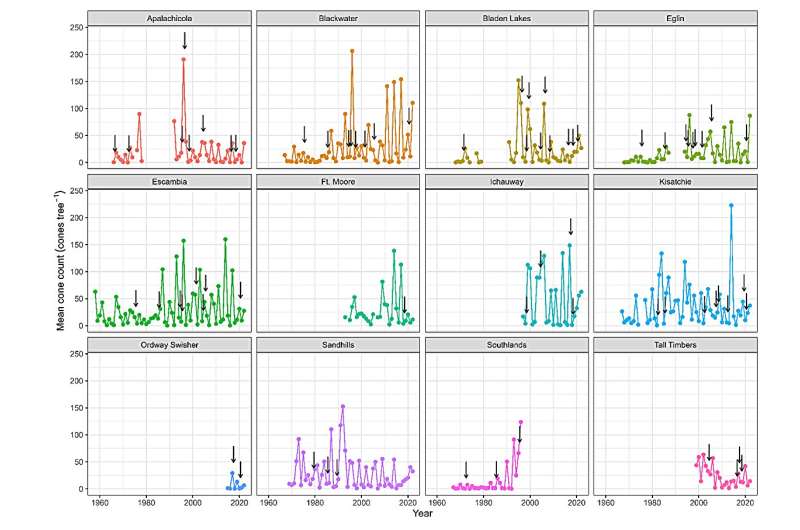This article has been reviewed according to Science X's editorial process and policies. Editors have highlighted the following attributes while ensuring the content's credibility:
fact-checked
peer-reviewed publication
proofread
Hurricanes found to boost cone production in longleaf pine

New research on tree reproduction is helping solve a puzzle that has stumped tree scientists for decades. Many tree species exhibit a reproductive phenomenon known as "masting," where individual trees have very low seed production in most years, followed by a sudden burst of seed production that is synchronized over large parts of its range. The reason for this coordinated reproduction within a species is unclear.
A new study by scientists at The Jones Center at Ichauway and the USDA Forest Service Southern Research Station showed that one pine species increases cone production in the years following a hurricane, which may explain why masting is observed in some coastal species.
"There are several hypotheses for why masting occurs," says the study's lead author Jeffery Cannon. "One idea is that seed-eating animals like rodents devour all available seed in most years. By making an occasional burst of seed production, trees can overwhelm seed-eaters and ensure some seeds are left over to germinate. Another explanation is that trees produce bumper seed crops if weather patterns foreshadow good conditions for germination success," he adds.
The research focused on longleaf pine, which is part of an imperiled ecosystem that once dominated the southeastern U.S. but now occupies only 5% of its historic range in small pockets throughout the region. Because of its status, the USDA Forest Service has tracked and reported pine cone production continuously since the 1950s. Reports on cone monitoring allow pine growers to take advantage of bumper seed crop years to improve reproduction and help restoration efforts.
"People who manage longleaf pine forests have long held the belief that seed production increases after hurricanes, but this is the first time anyone has tested it," says the study's co-author and manager of longleaf pine forests, Brandon Rutledge.
"In our study, we combined decades-long records of cone production with hurricane occurrence to see if mast years corresponded with hurricanes," explains Cannon. "We found that in the two years after a hurricane, cone production increases 31%, then 71%, before returning to baseline levels."
Hurricanes bring an average of four inches of rain in late summer, which is an otherwise dry period. This timely delivery of rain is most likely responsible for triggering the boost in reproduction, the study finds.
Other weather events, such as droughts or fires, can trigger masting in some species. Longleaf pine may be the first tree species where researchers discovered masting directly caused by hurricanes; however, many oak and pine species occur in hurricane-prone regions across the globe that may respond similarly. "Next, we hope to take a closer look at whether this is a widespread phenomenon," says Cannon.
Generally speaking, hurricanes can create good conditions for pine seed germination. Accompanying high winds topple trees, which provides extra light, as well as uproot trees, exposing bare soil that is necessary for longleaf pine seeds to germinate. "Our findings support the idea that trees can respond to weather conditions that lead to good germination environments. But it also helps us better appreciate the role of hurricanes," says Cannon. "Although they can sometimes be catastrophic, they can be also an integral part of the longleaf pine ecosystem."
The study is published in the journal New Phytologist.
More information: Jeffery B. Cannon et al, Tropical cyclone winds and precipitation stimulate cone production in the masting species longleaf pine (Pinus palustris), New Phytologist (2023). DOI: 10.1111/nph.19381
Journal information: New Phytologist
Provided by The Jones Center at Ichauway



















